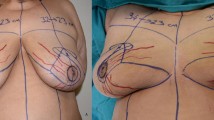Abstract
The purpose of this study is to introduce a breast reduction technique designed to reduce the incidence of postoperative nipple–areola complex ischemia and necrosis following reduction mammoplasty, while at the same time allowing all the other goals of breast reduction to be realized. This is achieved through preoperative detection of perforating vessels supplying the nipple–areola complex using a hand-held Doppler. The horizontally based parenchymal pedicle is designed to include these perforators whether originating from the internal mammary artery, lateral thoracic artery or both. This technique provides freedom in pedicle sha** and fixation to the pectoral fascia to achieve the best breast contour. The study included 50 patients equally divided into two groups: the study group (using preoperative Doppler for detection of perforators) and control group (without preoperative Doppler). The average body mass index of our patients was 32.4 and 29.8 for study and control groups, respectively. The average suprasternal notch to nipple distance was 40.8 cm in the study group and 38.9 cm in the control group. In all cases of the study group, both medial and lateral pedicles were used each of them containing one perforator. The average resection weight per side was 1433.6 g for the study group and 1173.2 g for the control group. None of the study group cases experienced NAC necrosis, while four cases of the control group experienced NAC necrosis (3 partial and 1 total). The horizontally based parenchymal pedicle constructed with the aid of preoperative perforator identification with a Doppler is an effective technique for breast reduction that results in a very low rate of postoperative ischemia and necrosis of the nipple–areola complex.
Level of Evidence IV This journal requires that authors assign a level of evidence to each article. For a full description of these Evidence-Based Medicine ratings, please refer to the Table of Contents or the online Instructions to Authors www.springer.com/00266.



Similar content being viewed by others
References
Hammond DC (2011) Reduction mammoplasty and mastopexy: general considerations. In: Spear SL (ed) Surgery of the breast: principles and art. Lippincott Williams & Wilkins, Philadelphia, p 955
Dm O’Dey, Prescher A, Pallua N (2007) Vascular reliability of nipple–areola complex-bearing pedicles: an anatomical microdissection study. Plast Reconstr Surg 119:1167–1177
Nakajima H, Imanishi N, Aiso S (1995) Arterial anatomy of the nipple–areola complex. Plast Reconstr Surg 96:843–845
Michelle le Roux C, Kiil BJ, Pan WR et al (2009) Preserving the neurovascular supply in the Hall-Findlay superomedial pedicle breast reduction: an anatomical study. J Plast Reconstr Aesthet Surg 63:655–662
Palmer JH, Taylor GI (1986) The vascular territories of the anterior chest wall. Br J Plast Surg 39:287–299
Loukas M, du Plessis M, Owens DG et al (2014) The lateral thoracic artery revisited. Surg Radiol Anat 36:543–549
Reid CD, Taylor GI (1984) The vascular territory of the acromiothoracic axis. Br J Plast Surg 37:194–212
van Deventer PV (2016) The blood supply of the breast revisited. Plast Reconstr Surg 137:1388–1397
Fournier PF (2010) Ch.17: Strombeck breast reduction technique. In: Shiffman MA, Di Guiseppe A (eds) Body contouring: art, science and clinical practice. Springer, Berlin, pp 155–167
Hamdi M, Wuringer E, Schlenz I et al (2005) Anatomy of the breast: a clinical application. In: Hamdi M, Hammond DC, Nahai F (eds) Vertical scar mammoplasty. Springer, Berlin, pp 1–8
van Deventer PV (2004) The blood supply to the nipple–areola complex of the human mammary gland. Aesthetic Plast Surg 28:393–398
Setala L, Papp A, Joukainen S et al (2007) Obesity and complications in breast reduction surgery: are restrictions justified? J Plast Reconstr Aesthet Surg 62:195–199
Cárdenas-Camarena L (2009) Reduction mammoplasty with superolateral dermoglandular pedicle: details of 15 years of experience. Ann Plast Surg 63:255–261
Hammond DC, O’Connor EA, Knoll GM (2015) The short-scar periareolar inferior pedicle reduction technique in severe mammary hypertrophy. Plast Reconstr Surg 135:34–40
Hall-Findlay EJ (2016) Discussion: the blood supply of the breast revisited. Plast Reconstr Surg 137:1398–1400
Horta R, Silva P, Filipe R et al (2010) Use of Doppler in breast reduction with superomedial or superolateral pedicles. Aesthetic Plast Surg 34:680–681
Basaran K, Ucar A, Guven E et al (2011) Ultrasonographically determined pedicled breast reduction in severe gigantomastia. Plast Reconstr Surg 128:252e–259e
Sarhadi NS, Dunn JS, Leet FD et al (1996) An anatomical study of the nerve supply of the breast, including the nipple and areola. Br J Plast Surg 49:156–164
Blondeel PN, Hmadi M, Van de Sijpe KA et al (2003) The latero-central glandular pedicle technique for breast reduction. Br J Plast Surg 56:348–359
Hamdi M, Blondeel P, Van de Sijpe KA et al (2003) Evaluation of nipple–areola complex sensitivity after the latero-central glandular pedicle technique in breast reduction. Br J Plast Surg 56:360–364
Author information
Authors and Affiliations
Corresponding author
Ethics declarations
Conflict of interest
The authors have no conflicts of interest to disclose.
Ethical Approval
All the procedures performed in this study that involved human participants were in accordance of the institutional, national research committee and with the 1964 Helsinki declaration and its later amendments or ethical standards.
Electronic supplementary material
Below is the link to the electronic supplementary material.
Rights and permissions
About this article
Cite this article
Elmelegy, N.G., Sadaka, M.S., Hegazy, A.M. et al. Treatment of Gigantomastia Using a Medial–Lateral Bipedicle Reduction Mammoplasty: The Role of Doppler-Assisted Preoperative Perforator Identification. Aesth Plast Surg 42, 73–79 (2018). https://doi.org/10.1007/s00266-017-1049-y
Received:
Accepted:
Published:
Issue Date:
DOI: https://doi.org/10.1007/s00266-017-1049-y




